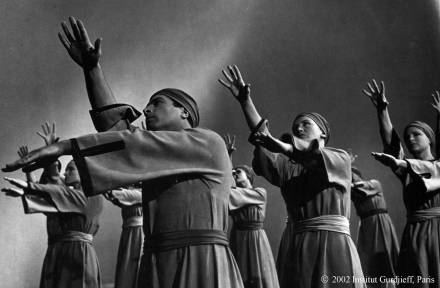

Music is patterns, like wallpaper. Some wallpaper makes people tense, some is more relaxing. Pattern in music is a movement away from balance, collecting energy—which can also be seen as an increase of tension—and the movement toward balance, releasing or expressing energy. Balancing can be seen as a relaxation which follows the accumulation of force.
Meaning is found in the relationship of tension to relaxation and can be experienced through arrangements of rhythm, harmony, and melody. We need to be aware of the gathering and discharge of energy when we listen to music.
Harmony, melody, and rhythm—if they all come to balance at the same time, there is a stop. In order to keep the music moving, at least one element needs to not come to balance.
You have the opportunity to express a rhythm, to find the rhythm, even when you are gardening. It’s there. Life is living in us. We don’t have to do it.
A metronome just measures space between the two points limiting the pendulum of the electric circuit. It doesn’t measure time. It forces something artificial.
Each register on the piano has its own tempo because of the differences in the time the sound waves take to complete themselves. The pianist has to be aware of the tempo of each octave, each world, and has to resonate and move the hands with the tempo of that world. To keep a steady tempo it is necessary to go against the natural law (the length of the wave).
Harmony brings the color.
Each harmonic relationship has a meaning. You need to get to know that. When I started working in this way, I felt that each cell in me was being filled: all the spaces were being filled with these vibrations.
When improvising for the Movements, melody must come from the harmony—otherwise you’re just “noodling.”
It begins in the mind—I hit the keys, I get the impressions, and only then does the music become a reality. Playing for Movements cannot be done by ear. We need knowledge.
“Inspiration” can be defined as rhythm, melody, and harmony all coming together. It happens in certain moments and then it is gone again. That is why we cannot depend on inspiration to play for Movements.
Write out lots of examples to avoid getting into a rut with your improvising.
We need to get this material into our fingers so we don’t have to think so much about it—then we can be open—the music can come into us.
The music has to like you and then you can do anything to it: hit it, push it around. The music has to like you … you need to like every one of the 88 keys.
Play the keys as if the keys themselves weren’t there—no hesitation on the key surface. Play as if you were conducting. Play the melody as if you were singing it or playing on the violin—sustain the tone. Don’t play cautiously or humbly. The music will humble you. Don’t go into the music—sit back from it and let it come into you.
| Copyright © 2002 The Estate of Mitchell Rudzinski This webpage © 2002 Gurdjieff Electronic Publishing Featured: Spring 2002 Issue, Vol. V (1) Revision: June 1, 2019 |
Mitchell Rudzinski (1922–2001) received a Master’s degree from Chicago Musical College, attended the American University of Biarritz, France, and studied composition with Max Wald and Paul Held. He joined the Gurdjieff Foundation in New York in the early 1950s where he learned to play for the Movements from Annette Herter. In 1970 he moved to San Francisco, where he taught students of the Movements music for the next 30 years. The legacy of some of his teaching can be found in a private publication entitled A Study of Piano Improvisation. These examples of Mitchell Rudzinski’s advice and comments to his students have been provided from their journals and notebooks.
